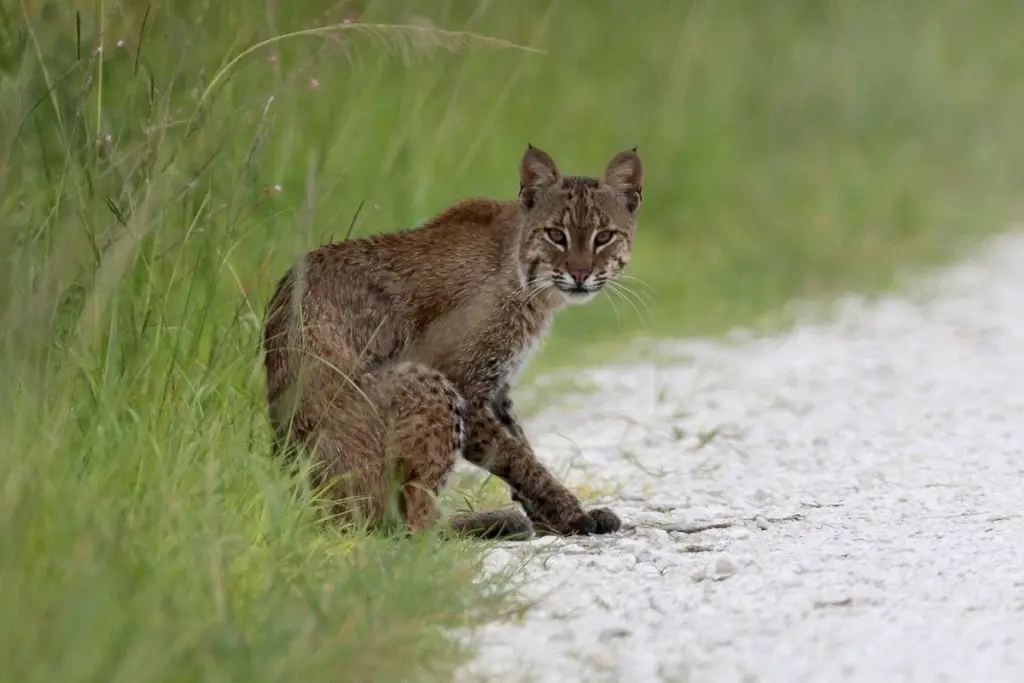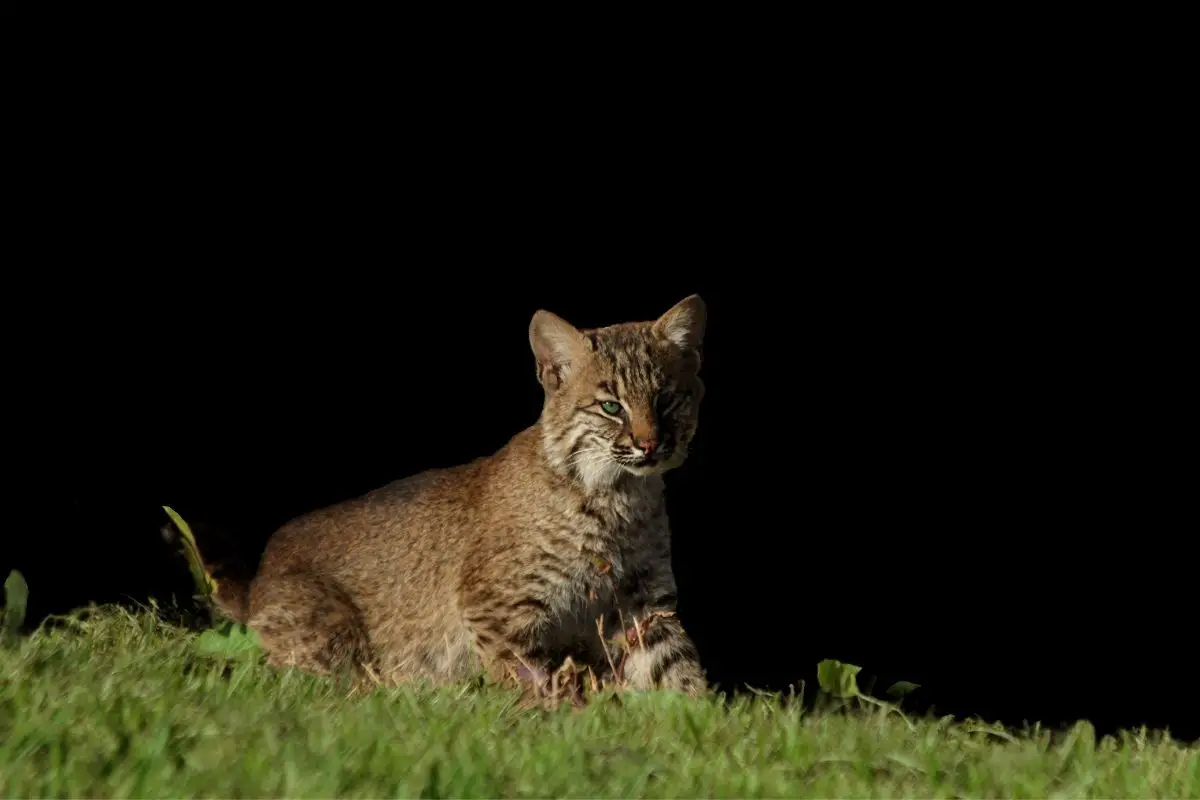Bobcats are wild animals that we rarely see in the daytime. So why do they mostly come out at night and are they considered nocturnal? Let’s take a closer look at what makes a bobcat tick.
Are Bobcats Nocturnal?
Bobcats were originally nocturnal animals, we know this because of their ability to see in low light. Over time they have adapted their behavior to be crepuscular, meaning they hunt in the twilight hours as well as night and can even be seen out in the daytime in some circumstances.
It’s rare to see a bobcat out in the daytime, however, it doesn’t mean that anything is wrong. Bobcats adapt to survive. In an urban area where bobcats have been forced to share territory with humans, it’s not that unusual to see them out in the daytime.
They are mostly solitary creatures that try to avoid any contact with humans or other predators. For this reason, they mostly hunt at night or in twilight hours. This is when they are most active.
What Does it Mean to be Nocturnal?
Nocturnal animals generally do their hunting in the nighttime and sleep during the day. This is different than some animals and humans, who are active in the daytime, which is called being diurnal.
Many wild animals start as nocturnal, there is usually evidence of this from them being able to see in the dark or low light. However, as they evolve and adapt, they sometimes become crepuscular, meaning they are active at night, in the twilight hours, and even in the daytime.
Bobcats seem to have been nocturnal in the beginning and have switched their behavior to crepuscular. This is common for animals, where humans are moving closer to their territory. Or if their food source is more active at different hours. Bobcats adapt to survive.
Do Bobcats Hunt at Night?
Bobcats do most of their hunting at night. However, since they are crepuscular they will also hunt in twilight hours. Only on very rare occasions will you see a bobcat hunting in the daytime. This can occur if they are pushed into urban areas, or if their food source is active in the daytime.
Bobcats will adapt to their environment when it comes to behavior. Most of their prey consists of rodents and small game animals, so they can sometimes pick when to hunt since those creatures are active in the night and the day.
Do Bobcats Come Out During the Day?
Although it’s rare, bobcats can come out during the day. In a situation where their prey is active only in the day, in their territory, they will hunt when the prey is active, or move their home range to a better food source.
Bobcats are solitary, so they will avoid any human activity. If you do see a bobcat out in the day, then their territory is most likely overlapping with an urban area. You should take precautions if you see a bobcat out in the day, observe, but keep your distance.

What Time of Day are Bobcats Most Active?
Bobcats are most active at night. This allows them to avoid most human contact and gives them an advantage against the small game animals that may be bedding down for the night. Cats of all sizes are known as night wanderers.
If a bobcat does hunt during day hours, it will most likely be during twilight. This means they will hunt during the sunrise and the sunset. This is also a time when a lot of their prey is active. In the daytime, a bobcat might be active if it is marking territory or looking for a new den.
Studies have also shown that illumination affects the movements of bobcats in the day or night. On nights that there is less illumination, such as new moons, bobcats may be more active in the daytime, and vise versa. Source.
How Can You Tell if a Bobcat is Around?
Bobcats tend to keep to themselves, they lurk around trying to be unseen. However, there are still physical signs that can help you figure out if a bobcat is around your home or neighborhood. If you do think a bobcat is around, you may need to take precautions, by fortifying your yard and keeping children and housepets inside.
One of the most used ways to track if a bobcat is nearby is to look at the scat and poo that is in your yard or area. This can tell a lot about what animals are creeping around at night. Bobcat scat is usually tubular and around 4 inches long and 3/4ths of an inch thick. They will also mark with urine.
Another sign that a bobcat is nearby is large scratch marks on things like stumps and claw marks in the mud. Bobcats sometimes mark their territory by scratching objects.
What To Do if You See a Bobcat?
If you see a bobcat, you may decide to observe it, since it’s a rare occasion, however, do not approach it and keep your distance. People have gotten some incredible pictures by happening upon a bobcat in nature.
See our article for Are Bobcats Dangerous?
Bobcats are wild animals, and should not be touched, petted, or messed with, in the wild. Some people have raised bobcats as pets, but this process tames the animal, over a long period, and even then they can attack their owners because they are only tamed and not domesticated.
Other Nocturnal Hunters and Enemies of Bobcats
Bobcats may have overlapping territory with other nocturnal predators. This can make them prey for a larger carnivore. Bobcat kittens are especially susceptible to predation. Large carnivores such as wolves and cougars may kill a bobcat over territory.
Kittens are small and can be snatched up by multiple carnivores, however, female bobcats are very protective of their kittens. If the mother is around when a predator approaches the kittens, there will no doubt, be a fight. If you have ever seen a wild animal defend their young, then you know, that is a fight that most natural enemies will want to avoid.
Why Bobcats Continue to Adapt
Even though bobcats are primarily nocturnal, they continue to adapt over time. Their populations grow constantly because of their ability to adapt. They know when a food source is active and will adapt their behavior to be crepuscular. They will sometimes take on the schedules of humans in urban areas, or if they are kept as pets.
Bobcats will do whatever it takes to survive. This is why they are so widespread in North America. They have managed to expand their territory and home range as far south as Mexico. This is not by accident, this is because of their ability to adapt to different climates, and find new food sources.
Bobcats Nocturnal Habitats
Because bobcats are still partially nocturnal, they have kept many of their nocturnal habits. The night provides them with the perfect killing grounds, a way to stay unseen, and an edge over small game animals who cannot see well at night.
Bobcats can see in low light, this is how we know they were originally fully nocturnal. This is also why they do so well in twilight hours. Bobcats have very good eyesight, and being able to see in low light gives them the ultimate advantage. Their pupils are vertical slits, which open wide so they can see in different types of light. Source.
It allows them to capture prey easier, avoid natural enemies, and lets them live peacefully in their home ranges.
Conclusion
While it may be more accurate to say that bobcats are crepuscular, there is no doubt that they prefer the night. Their ability to see in the dark just signifies that they were nocturnal.
Different bobcats may exhibit different behaviors, one bobcat may be completely nocturnal, while another will be crepuscular. I hope this has helped clarify the answer to, are bobcats nocturnal? Yes, in most situations they are.
- Hero Farm Dog Survives Epic Battle with Coyote Pack - December 9, 2024
- The 10-Minute Bedtime Routine That Changed My Dog’s Sleep Forever - November 29, 2024
- Creating a Safe Space for Nervous Pets: Your Guide to Pet-Friendly Havens - November 25, 2024

